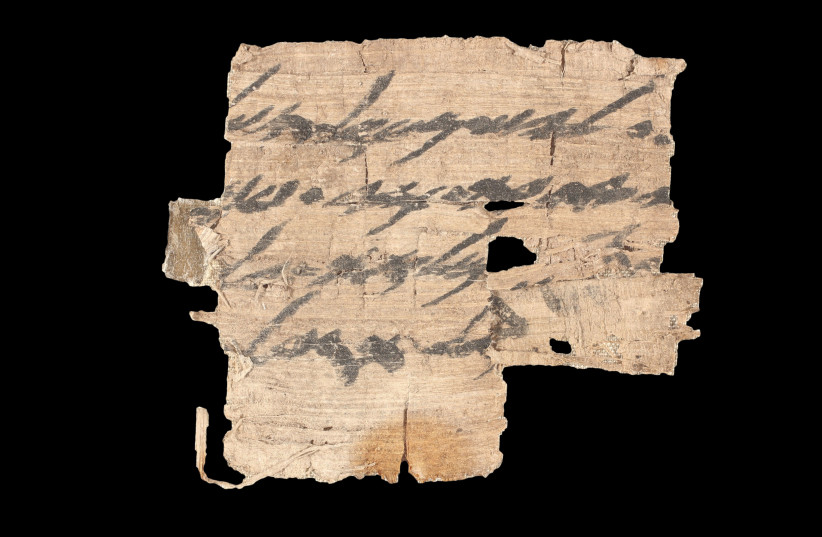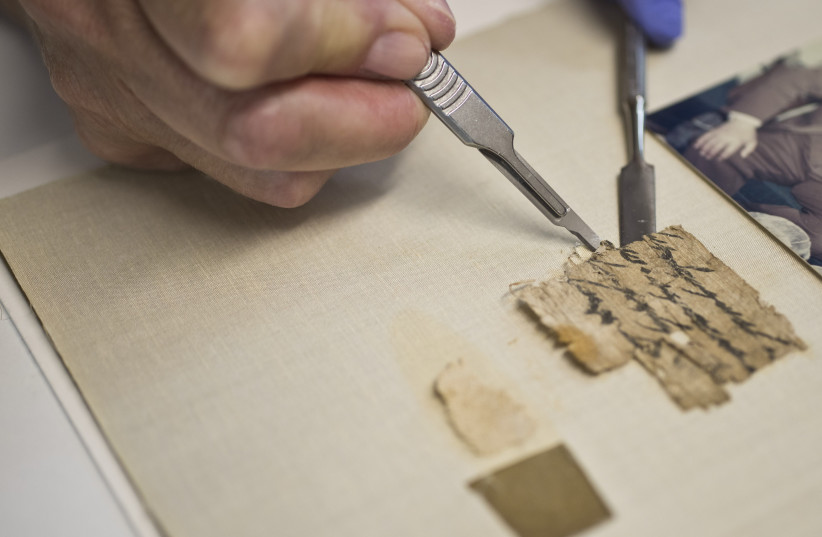 Ancient Hebrew letter from First Temple period returned to Israel – watch
Ancient Hebrew letter from First Temple period returned to Israel – watch
JERUSALEM POST STAFF
The letter written in ancient Hebrew, originally found in the Judean Desert caves, ended up in Montana and was then returned to Israel.
.

A letter written in ancient Hebrew dating back to the First Temple period, around the sixth or seventh century BCE, was returned to Israel on Wednesday. It was probably found in the Judean Desert caves.
Archaeologists estimated that it dates back to the sixth century BCE which joins two other documents in this time period in the Israel Antiquities Authority Dead Sea Scrolls collection. The script on the extremely rare ripped document starts with “To Ishmael send…”, hinting that it is a fragment of a letter.
According to a Wednesday press release, the letter was returned thanks to a joint operation by the Antiquities Theft Prevention Unit of the Israel Antiquities Authority, the Culture and Sport Ministry and the Jerusalem Affairs and Heritage Ministry.
Who are the archaeologists behind the research?
Dr. Ada Yardeni, an Ancient Hebrew Script scholar, passed away back in June 2018 and Prof. Shmuel Ahituv was asked to take over and complete the publication of a document that she was working on before she passed.
According to the announcement, he was surprised to find a photograph of a rare and, until then unknown, document from the First Temple period with Yardeni’s decipherment. This all led to the joint Intelligence operation finding the rest of the original documents.

They found a person who lives in Montana, USA, who owned the parchment.
He explained that it was given to his mother, who had hung it on her wall. She got it on a visit to Jerusalem in 1965 from Joseph Sa’ad, a well-known antiquities dealer from Bethlehem. Sa’ad was known to have sold thousands of Dead Sea scroll fragments over the years.
The man was convinced to give the fragment over to Israel after he was invited to visit the Israel Antiquities Authority Judean Desert Scroll Department’s Conservation Laboratory in Jerusalem.
What’s in a name?
“The name Ishmael mentioned in the document, was a common name in the Biblical period, meaning ‘God will hear,'” Ahituv said.
“It first appears in the Bible as the name of the son of Abraham and Hagar, and it is subsequently the personal name of several individuals in the Bible, including Yishmael ben Netanyahu, who murdered the governor Gedaliah ben Ahikam.
“It also appears as the name of officials on paleographic finds such as bullae (clay stamp seals) used for sealing royal documents in the administration of the Kingdom of Judea, for example, the bulla reading, ‘To Yishmael, song of the king,'” he added.
Director of the Israel Antiquities Authority Judean Desert Scrolls Unit, Dr. Joe Uziel said: “Towards the end of the First Temple period, writing was widespread. This is evident from many finds, including groups of ostraca (documents written on pottery shards) and stamp seals with writing, that have been discovered in many ancient urban settlements.
“Each new document sheds further light on the literacy and the administration of the First Temple period,” he added.
The story about the document will be presented at the First Judean Desert Conference taking place at the Bible Lands Museum in Jerusalem next week. The conference is open to the public, free of charge.
In a joint intelligence operation, the Antiquities theft Prevention Unit of the Israel Antiquities Authority, and Professor Shmuel Ahituv, recipient of the Israel Prize for Biblical Studies, with the help of the Ministry of Culture and Sport and the Ministry of Jerusalem and Heritage, succeeded in repatriating a First Temple-period document, dated to the late seventh or early sixth century BCE. The document is written in ancient Hebrew script on papyrus, and it was probably found in the Judean Desert caves.
The extremely rare document is composed of four torn lines that begin with the words “To Ishmael send….”, the text hinting that it is a fragment of a letter containing instructions to the recipient. Based on the writing, it is proposed to date the ‘Ishmael Papyrus’ to the seventh to sixth centuries BCE, joining only two other documents from this period in the Israel Antiquities Authority Dead Sea Scrolls collection. All three papyri come from the Judean Desert, where the dry climate enables the preservation of the papyri.
The story began when Dr. Ada Yardeni, scholar of Ancient Hebrew Script, passed away in June 2018, and Prof. Shmuel Ahituv was asked to complete the publication of a document she was working on. Ahituv was surprised to encounter the photograph of a rare and, until then unknown, document from the First Temple period, together with Yardeni’s preliminary decipherment. This led to a joint campaign by Ahituv and the Antiquities theft Prevention Unit of the Israel Antiquities Authority to locate the whereabouts of the original document.
The intelligence mission succeeded, and the person who owned the papyrus, a resident of Montana, USA, was located. He explained that the papyrus was given to his mother when she visited Jerusalem in 1965, by Joseph Sa‘ad, Curator of the Rockefeller Museum, and Halil Iskander Kandu, a well-known antiquities dealer from Bethlehem, who many years ago sold thousands of Dead Sea scroll fragments. Back home, his mother hung the framed scroll fragment on the wall.
In order to persuade the owner to transfer the fragile document to Israel, where it would be conserved in climate-controlled conditions, he was invited to visit the Israel Antiquities Authority Judean Desert Scroll Department’s Conservation Laboratory in Jerusalem. After the visit, the owner was convinced that here were the best conditions to conserve and research the rare document, and he generously gave it to the Israel Antiquities Authority.
The Dead Sea Scrolls Unit conserved the papyrus and documented it with the modern multispectral system used to monitor the state of the scrolls.
In order to confirm that the document was genuine, a small sample was radiometrically dated in the Weizmann Institute in Rehovot. The sample provided a date similar to that determined by the paleographic evaluation (based on the letter forms), thus consolidating the dating towards the end of the First Temple period.
The document was researched by Prof. Ahituv, and his findings will be presented next Thursday at the Israel Antiquities Authority’s First Judean Desert Conference at the Bible Lands Museum in Jerusalem.
According to Professor Shmuel Ahituv, “The name Ishmael mentioned in the document, was a common name in the Biblical period, meaning ‘God will hear’. It first appears in the Bible as the name of the son of Abraham and Hagar, and it is subsequently the personal name of several individuals in the Bible, including Yishmael ben Netanyahu, who murdered the governor Gedaliah ben Ahikam. It also appears as the name of officials on paleographic finds such as bullae (clay stamp seals) used for sealing royal documents in the administration of the Kingdom of Judah, for example the bulla reading, ‘To Yishmael, son of the king’. The present document probably certified a dispatchment either to, or from, Yishmael.”
“Towards the end of the First Temple period, writing was widespread,” says Dr. Joe Uziel, Director of the Israel Antiquities Authority Judean Desert Scrolls Unit. “This is evident from many finds, including groups of ostraca (documents written on pottery sherds) and stamp seals with writing, that have been discovered in many ancient urban settlements, including in the royal capital of Jerusalem. However, First Temple-period documents written on organic materials—such as this papyrus—have scarcely survived. Whilst we have thousands of scroll fragments dating from the Second Temple period, we have only three documents, including this newly found one, from the First Temple period. Each new document sheds further light on the literacy and the administration of the First Temple period.”
Zawartość publikowanych artykułów i materiałów nie reprezentuje poglądów ani opinii Reunion’68,
ani też webmastera Blogu Reunion’68, chyba ze jest to wyraźnie zaznaczone.
Twoje uwagi, linki, własne artykuły lub wiadomości prześlij na adres:
webmaster@reunion68.com
